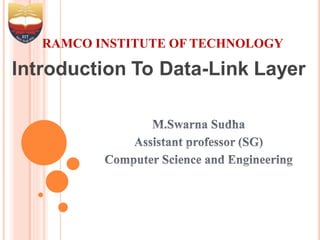
Introduction to data link layer
- 1. RAMCO INSTITUTE OF TECHNOLOGY
- 2. Introduction • The Internet is a combination of networks glued together by connecting devices (routers or switches). If a packet is to travel from a host to another host, it needs to pass through these networks.
- 4. Nodes and Links • Communication at the data-link layer is node-to-node. • A data unit from one point in the Internet needs to pass through many networks (LANs and WANs) to reach another point. Theses LANs and WANs are connected by routers. • It is customary to refer to the two end hosts and the routers as nodes and the networks in between as links.
- 6. Services • The data-link layer is located between the physical and the network layers. • The data-link layer provides services to the network layer; it receives services from the physical layer • The duty scope of the data-link layer is node-to-node.
- 7. • Data-link layer of the sending node needs to encapsulate the datagram received from the network in a frame, and the data-link layer of the receiving node needs to decapsulate the datagram from the frame. • In other words, the data-link layer of the source host needs only to encapsulate, the data-link layer of the destination host needs to decapsulate, but each intermediate node needs to both encapsulate and decapsulate
- 9. Framing • First service provided by the data-link layer is framing. The data-link layer at each node needs to encapsulate the datagram (packet received from the network layer) in a frame before sending it to the next node
- 10. Flow control • Flow control is a technique that allows two stations working at different speeds to communicate with each other. • It is a set of measures taken to regulate the amount of data that a sender sends so that a fast sender does not overwhelm a slow receiver.
- 11. Error Control • Error control in data link layer is the process of detecting and correcting data frames that have been corrupted or lost during transmission. .. • Data link layer follows a technique to detect transit errors and take necessary actions, which is retransmission of frames whenever error is detected or frame is lost.
- 12. Two Categories of Links • Although two nodes are physically connected by a transmission medium such as cable or air, we need to remember that the data-link layer controls how the medium is used. • We can have a data-link layer that uses the whole capacity of the medium; we can also have a data-link layer that uses only part of the capacity of the link. • In other words, we can have a point-to- point link or a broadcast link.
- 13. • To better understand the functionality of and the services provided by the link layer, we can divide the data-link layer into two sublayers: • Data link control (DLC) and • Media access control (MAC).
- 14. Two Sub layers
- 15. LINK-LAYER ADDRESSING • we cannot make a datagram reach its destination using only IP addresses. • The source and destination IP addresses define the two ends but cannot define which links the packet should pass through. • so we need link layer address
- 16. • IP addresses in a datagram should not be changed. • If the destination IP address in a datagram changes, the packet never reaches its destination; • if the source IP address in a datagram changes, the destination host or a router can never communicate with the source if a response needs to be sent back or an error needs to be reported back to the source
- 18. Three Types of addresses • Link-layer protocols define three types of addresses: • Unicast, Multicast, and Broadcast. • Unicast Address • Each host or each interface of a router is assigned a unicast address. • Unicasting means one-to-one communication.
- 19. • Multicast Address: Some link-layer protocols define multicast addresses. Multicasting means one-to-many communication. • Broadcast Address • Some link-layer protocols define a broadcast address. Broadcasting means one-to-all communication. A frame with a destination broadcast address is sent to all entities in the link
- 20. Address Resolution Protocol • Anytime a node has an IP datagram to send to another node in a link, it has the IP address of the receiving node. • However, the IP address of the next node is not helpful in moving a frame through a link; we need the link-layer address of the next node. This is the time when the Address Resolution Protocol (ARP) becomes helpful.
- 21. Position of ARP in TCP/IP protocol suite
- 22. • Anytime a host or a router needs to find the link- layer address of another host or router in its network, it sends an ARP request packet. • The packet includes the link-layer and IP addresses of the sender and the IP address of the receiver. • Because the sender does not know the link-layer address of the receiver, the query is broadcast over the link using the link-layer broadcast address
- 23. ARP operation
- 24. • Every host or router on the network receives and processes the ARP request packet, but only the intended recipient recognizes its IP address and sends back an ARP response packet. • The response packet contains the recipient’s IP and link-layer addresses. The packet is unicast directly to the node that sent the request packet
- 25. ARP packet
- 26. • The hardware type field defines the type of the link-layer protocol; Ethernet is given the type 1. • The protocol type field defines the network- layer protocol: IPv4 protocol is (0800)16. • The source hardware and source protocol addresses are variable-length fields defining the link-layer and network-layer addresses of the sender